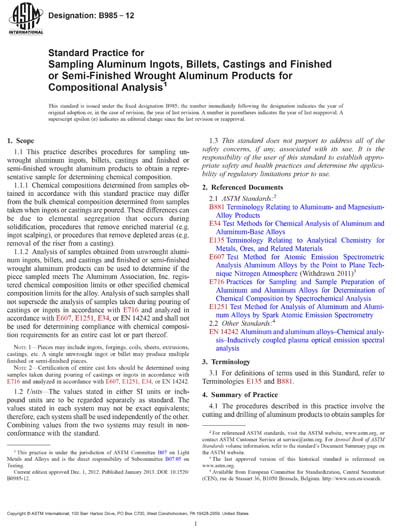Historical
ASTM B985-12
Standard Practice for Sampling Aluminum Ingots, Billets, Castings and Finished or Semi-Finished Wrought Aluminum Products for Compositional Analysis
1.1 This practice describes procedures for sampling unwrought aluminum ingots, billets, castings and finished or semi-finished wrought aluminum products to obtain a representative sample for determining chemical composition.
1.1.1 Chemical compositions determined from samples obtained in accordance with this standard practice may differ from the bulk chemical composition determined from samples taken when ingots or castings are poured. These differences can be due to elemental segregation that occurs during solidification, procedures that remove enriched material (e.g. ingot scalping), or procedures that remove depleted areas (e.g. removal of the riser from a casting).
1.1.2 Analysis of samples obtained from unwrought aluminum ingots, billets, and castings and finished or semi-finished wrought aluminum products can be used to determine if the piece sampled meets The Aluminum Association, Inc. registered chemical composition limits or other specified chemical composition limits for the alloy. Analysis of such samples shall not supersede the analysis of samples taken during pouring of castings or ingots in accordance with E716 and analyzed in accordance with E607, E1251, E34, or EN 14242 and shall not be used for determining compliance with chemical composition requirements for an entire cast lot or part thereof.
1.2 Units—The values stated in either SI units or inch-pound units are to be regarded separately as standard. The values stated in each system may not be exact equivalents; therefore, each system shall be used independently of the other. Combining values from the two systems may result in non-conformance with the standard.
1.3 This standard does not purport to address all of the safety concerns, if any, associated with its use. It is the responsibility of the user of this standard to establish appropriate safety and health practices and determine the applicability of regulatory limitations prior to use.
ASTM International [astm]

